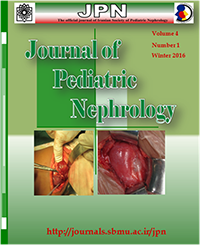Is Additional Fluid Therapy Effective in the Treatment of Children with Urinary Tract Infection?
Journal of Pediatric Nephrology,
Vol. 4 No. 1 (2016),
13 February 2016
,
Page 25-29
https://doi.org/10.22037/jpn.v4i1.9033
Abstract
Introduction: Urinary tract infection can result in many complications such as abscess, hypertension, renal failure, renal scar, reflux, etc. Since there is no general agreement on the administration of additional fluid (1.5 times maintenance) for the early treatment of UTI, this study was conducted to evaluate the effect of additional fluid therapy.
Materials and Methods: In This clinical trial study, 206 children with UTI who were admitted at Amir Kabir Hospital (Arak, Iran) from March 2012 to March 2013 were divided into two groups of 103. One group received the usual amount of maintenance fluid while the other group received 1.5 times more than usual maintenance. The course of the resolution of dysuria, frequency, malodorous urine, abdominal pain, and fever was compared between the two groups. Urine culture was performed for all patients 2, 7-10, and 90 days after admission. The patients were age and sex matched. The data was analyzed using descriptive statistics and the X2 method based on independent sample t-test.
Results: Additional fluid had a significant effect on malodorous urine dysuria. However, it had an inverse effect on the treatment of fever and urinary frequency as it made them last longer. There was no difference in other parameters like abdominal pain and urine culture in 3 stages.
Conclusions: Based on our study, the intake of excessive amounts of water has no significant effects on the results of the UTI treatment. However, due to lack of adequate evidence, further studies should be conducted in this field.
Keywords: Urinary Tract Infection; Child; Fluid Therapy.How to Cite
References
- Jodal u, Sverker H. Urinary tract infection. In: Barratt M, editor. Pediatric Nephrology 4th ed. Philadelphia: Lippincott Williams &wilkins company, 1999. p. 835-850.
- Kliegman RM, Behrman RE, Jenson HB, Stanton BF.Nelson Textbook of Pediatrics. 19th ed. Philadelphia, PA: Saunders; 2011.
- Kaplan S. Urinary tract infection. In: Feigin F, Cherry J, Demmler G, editors. Pediatric infectious disease, 5th ed. Philadelphia: W.B. Saunders, 2004. P.541-553.
- Hansson S, Jodal U. Urinary tract infection. In: Avner ED, Harmon WE, Niaudet P, editors. Pediatric Nephrology, 5th ed. Philadelphia: Lippincott Williams & Wilkins. 2003.p 1007-1021.
- Jacobson S, Eklof O, Lins LE. Long-term prognosis of post-infectious renal scarring in relation to radiological findings in childhood a 27 year follow up. pediatrNephrol. 1992; 6 : 19-24.
- Levtchenko E, lahy C, leuy J. Treatment of children with acute pyelonephritis a prospective randomized study. Pediatric Nephrology.2001; 16: 878-884.
- Rushton HG. The evaluation of acute pyelonephritis and renal scarring with technetium 99mdimercaptosuccinic acid Rend scintigraphy (DMSA): evolving concepts and future directions. Pediatric Nephrology.1997; 11: 108-0120.
- Baker PC, Nelson DS, schunl JE. The addition of ceftriaxone to oral therapy does not improve outcome in febrile children with urinary tract infections, Arch pediatric Adolescent Med. 2001; 155: 135 -139.
- Hellerstein S, Kennedy E, Nussbaum L, Rice K. Localization of the site of urinary tract infections by means of antibody- coated bacteria in the urinary sediments. J Pediatr.1978; 92: 188-193.
- Hoberman A, Wald ER, Hichey RW. Oral versus initial intravenous therapy for urinary tract infections in young febrile children.Pediatrics. 1999: 104: 79-86.
- Wennerstrom M, Hansson S, Todal U. Renal function 16-26 years after the first urinary tract infection in childhood. Arch pediatric Adolescents Med. 2000; 154: 339-345.
- Rushton HG, Majd M, Jantausch B. Renal Scarring following reflux and nonreflux pyelonephritis in children: evaluation with 99m-technetium- dimercaptosuccinic acid scintigraphy (DMSA): J Urology. 1992; 147: 1327-1332.
- Wennerstrom M, Hansson S, Jodal U. Primary and acquired Rend scarring in boys and girls with urinary tract infection. J Pediatric.2000; 136-34.
- Abrahamsson K, Hansson S, Larsson P. Antibiotic treatment for five days in effective in children with acute cystitis. Acta Pediatric.2002; 91: 55-58.
- Jodal U. suprapubic aspiration of urine in the diagnosis of urinary tract infection in infants.Acta Pediatric. 2002;
- Abstract Viewed: 456 times
- PDF Downloaded: 253 times

